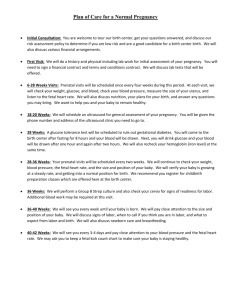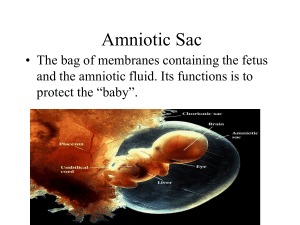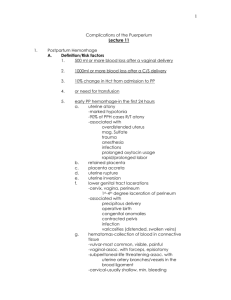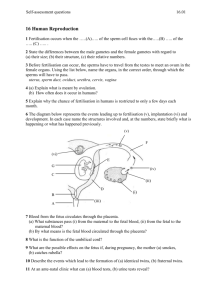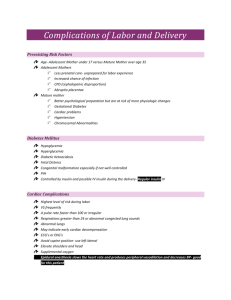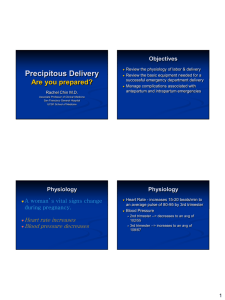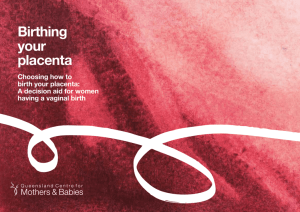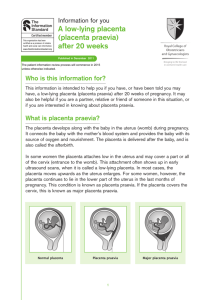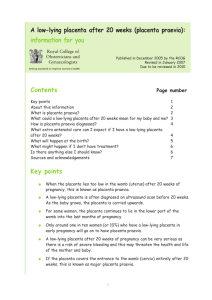Delivery
advertisement
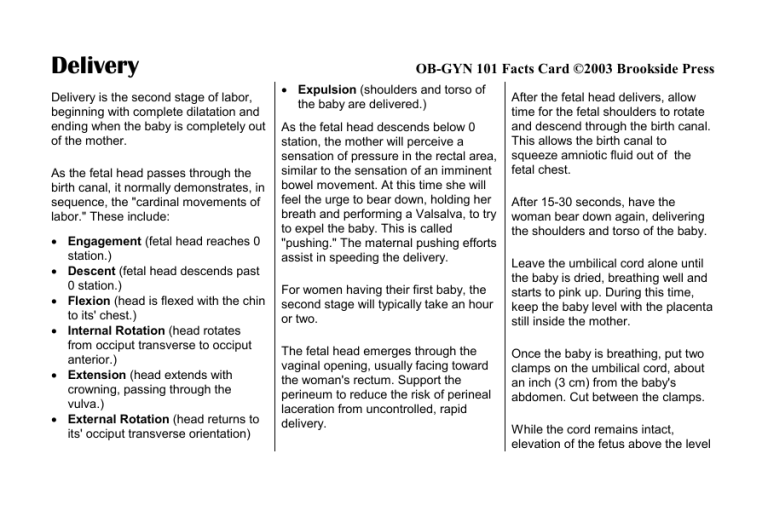
Delivery Delivery is the second stage of labor, beginning with complete dilatation and ending when the baby is completely out of the mother. As the fetal head passes through the birth canal, it normally demonstrates, in sequence, the "cardinal movements of labor." These include: Engagement (fetal head reaches 0 station.) Descent (fetal head descends past 0 station.) Flexion (head is flexed with the chin to its' chest.) Internal Rotation (head rotates from occiput transverse to occiput anterior.) Extension (head extends with crowning, passing through the vulva.) External Rotation (head returns to its' occiput transverse orientation) OB-GYN 101 Facts Card ©2003 Brookside Press Expulsion (shoulders and torso of the baby are delivered.) As the fetal head descends below 0 station, the mother will perceive a sensation of pressure in the rectal area, similar to the sensation of an imminent bowel movement. At this time she will feel the urge to bear down, holding her breath and performing a Valsalva, to try to expel the baby. This is called "pushing." The maternal pushing efforts assist in speeding the delivery. For women having their first baby, the second stage will typically take an hour or two. The fetal head emerges through the vaginal opening, usually facing toward the woman's rectum. Support the perineum to reduce the risk of perineal laceration from uncontrolled, rapid delivery. After the fetal head delivers, allow time for the fetal shoulders to rotate and descend through the birth canal. This allows the birth canal to squeeze amniotic fluid out of the fetal chest. After 15-30 seconds, have the woman bear down again, delivering the shoulders and torso of the baby. Leave the umbilical cord alone until the baby is dried, breathing well and starts to pink up. During this time, keep the baby level with the placenta still inside the mother. Once the baby is breathing, put two clamps on the umbilical cord, about an inch (3 cm) from the baby's abdomen. Cut between the clamps. While the cord remains intact, elevation of the fetus above the level of the placenta results in pooling of newborn blood within the making the baby somewhat anemic. Holding the baby below the level of the placenta results in pooling of placental blood within the newborn, leading to increased neonatal jaundice. Keep the baby level with the placenta until the cord is clamped. Lengthening of the cord. The uterus becomes globular. The uterus enlarges. If the baby is not breathing well after delivery and needs resuscitation, immediately clamp and cut the cord so you can move the baby to the resuscitation area. If the placenta is not promptly expelled, or if the patient hemorrhages while awaiting delivery of the placenta, this is called a "retained placenta" and it should be manually removed. After delivery of the baby, the placenta is still attached inside the uterus. Some time later, the placenta will detach from the uterus and then be expelled. This process is called the "3rd stage of labor" and may take just a few minutes or as long as an hour. After delivery of the placenta, the uterus normally contracts firmly, closing off the open blood vessels Without this contraction, rapid blood loss occurs. Signs of placenta separation include: A sudden gush of blood As the placenta separates, the woman will again feel painful uterine cramps. As the placenta descends, she will feel the urge to bear down and will push out the placenta. To firmly contract the uterus, give oxytocin 10 mIU IM or IV. Breast feeding the baby or providing nipple stimulation causes release of oxytocin, causing similar, but milder effects. Encourage firm uterine contraction with uterine massage.
